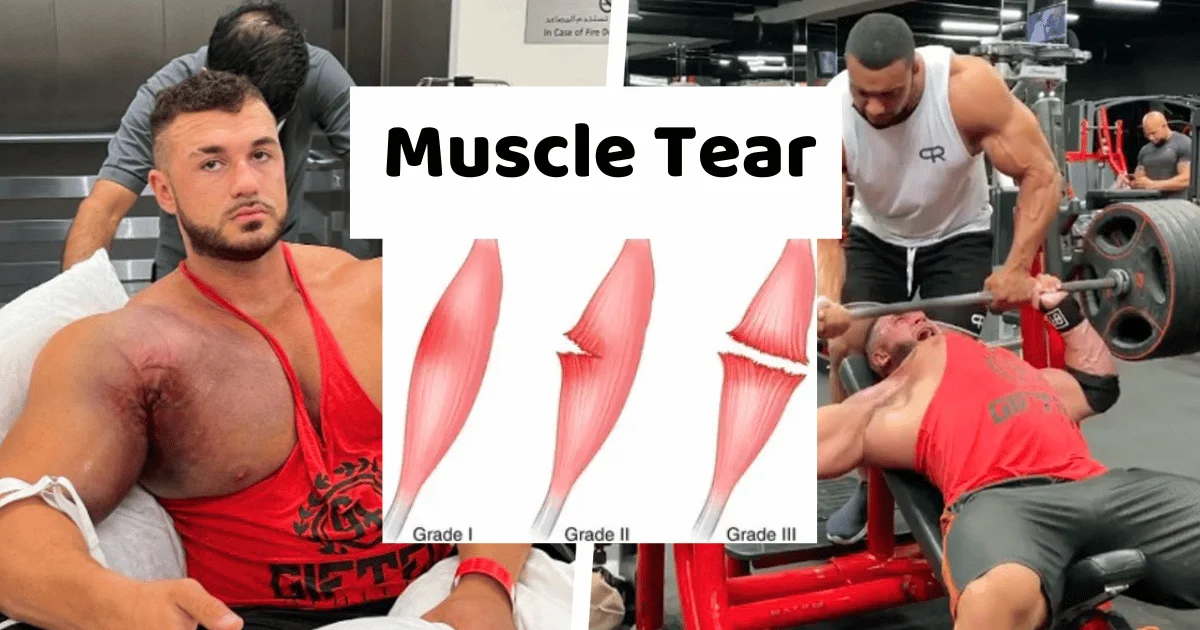Muscle Tear – Causes, Treatment, & How to Avoid
A muscle tear, also known as a muscle strain or pulled muscle, occurs when the muscle fibers stretch beyond their limit and tear due to overexertion, sudden force, or repetitive use. This injury can range from mild, involving minor damage to the muscle fibers, to severe, where there is a complete rupture or tear of the muscle.
When a muscle is stretched too far or used excessively, the muscle fibers can sustain damage. This damage can be categorized into three grades:
- Grade 1: Involves mild stretching or micro-tears of the muscle fibers. This often leads to minor discomfort and minimal loss of function.
- Grade 2: Involves a partial tear of the muscle fibers, causing moderate pain, swelling, bruising, and a noticeable loss of function.
- Grade 3: Represents a severe tear or complete rupture of the muscle. This results in severe pain, significant swelling, extensive bruising, and a substantial loss of function.
Muscle tears can happen in various muscles throughout the body and are commonly seen in muscles involved in athletic activities or movements that require sudden exertion, like running, jumping, or lifting heavy objects.
Major Causes
- Overexertion or Overuse: Performing repetitive motions or putting excessive stress on a muscle without adequate rest can lead to strain. This often happens during sports, exercise, or physically demanding work.
- Sudden Movements or Trauma: Rapid movements, sudden changes in direction, or direct impact or trauma to the muscle can cause it to stretch beyond its capacity, leading to tears.
- Lack of Warm-Up or Improper Stretching: Not properly warming up before exercise or engaging in physical activity can make muscles more prone to injury. Similarly, incorrect stretching techniques can strain muscles.
- Fatigue or Weakness: Muscles that are tired or weakened are more susceptible to tears. This can occur due to inadequate recovery time between workouts, insufficient nutrition, or underlying health conditions.
- Age and Muscle Condition: Aging can lead to a gradual decline in muscle elasticity and strength, making muscles more vulnerable to tears. Additionally, pre-existing muscle weaknesses or imbalances can increase the risk.
- Improper Technique: Incorrect posture, form, or technique during physical activities or weightlifting can strain muscles and increase the risk of injury.
- Dehydration and Fatigue: Not maintaining proper hydration levels or pushing the body beyond its limits when fatigued can increase the likelihood of muscle tears.
Treatments
The treatment for a muscle tear typically involves a combination of approaches aimed at reducing pain, swelling, promoting healing, and restoring function. Here are some common treatments:
Immediate Care:
- Rest: Avoid activities that strain the affected muscle to prevent further damage.
- Ice: Apply ice wrapped in a cloth to the injured area for 15-20 minutes every few hours in the first 48 hours to reduce swelling and pain.
- Compression: Use an elastic bandage or compression wrap to support the injured muscle and reduce swelling.
- Elevation: Raise the affected area above heart level to minimize swelling.
Medications:
- Pain Relievers: Over-the-counter pain medications like ibuprofen, acetaminophen, or naproxen can help alleviate pain and reduce inflammation. Always follow dosage instructions.
Medical Treatment:
- Physical Therapy: Once the acute phase passes, physical therapy is essential. A therapist can guide you through exercises to restore strength, flexibility, and function.
- Professional Evaluation: For severe tears or significant pain, consult a doctor. They might recommend imaging tests like MRI or ultrasound to assess the extent of the injury.
Rehabilitation:
- Progressive Exercises: Gradually reintroduce movement and exercise to the affected muscle under the guidance of a healthcare professional.
- Stretching and Strengthening: Targeted exercises can help rebuild strength and flexibility in the injured muscle.
- Functional Training: Specific exercises mimic daily activities to help regain normal function.
Prevention:
- Proper Warm-Up and Stretching: Always warm up before exercising or engaging in physical activities. Dynamic stretching can help prepare muscles for activity.
- Proper Technique: Use correct form and technique when exercising or participating in sports to reduce the risk of injury.
- Adequate Rest and Recovery: Allow sufficient time for rest between workouts and ensure adequate sleep and nutrition to support muscle recovery.
Medical Intervention:
For severe muscle tears that involve a complete rupture or severe pain, surgical intervention might be necessary. However, this is less common and usually reserved for more severe cases.
Always seek professional medical advice for proper diagnosis and a tailored treatment plan based on the severity of the muscle tear.
To become a certified personal trainer, click below




